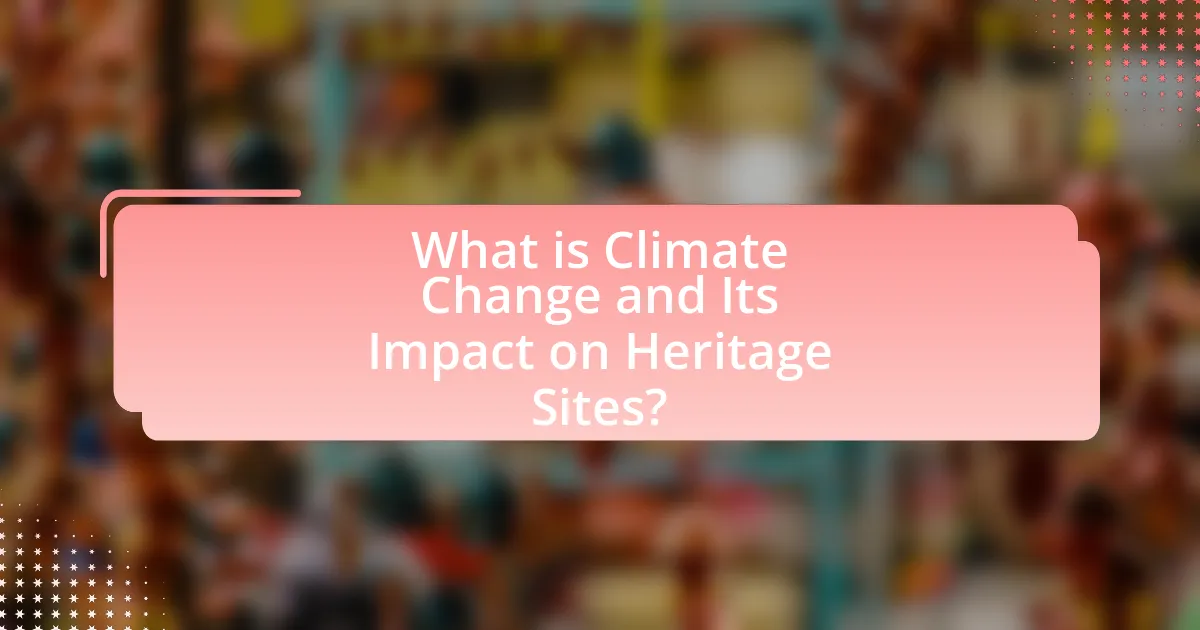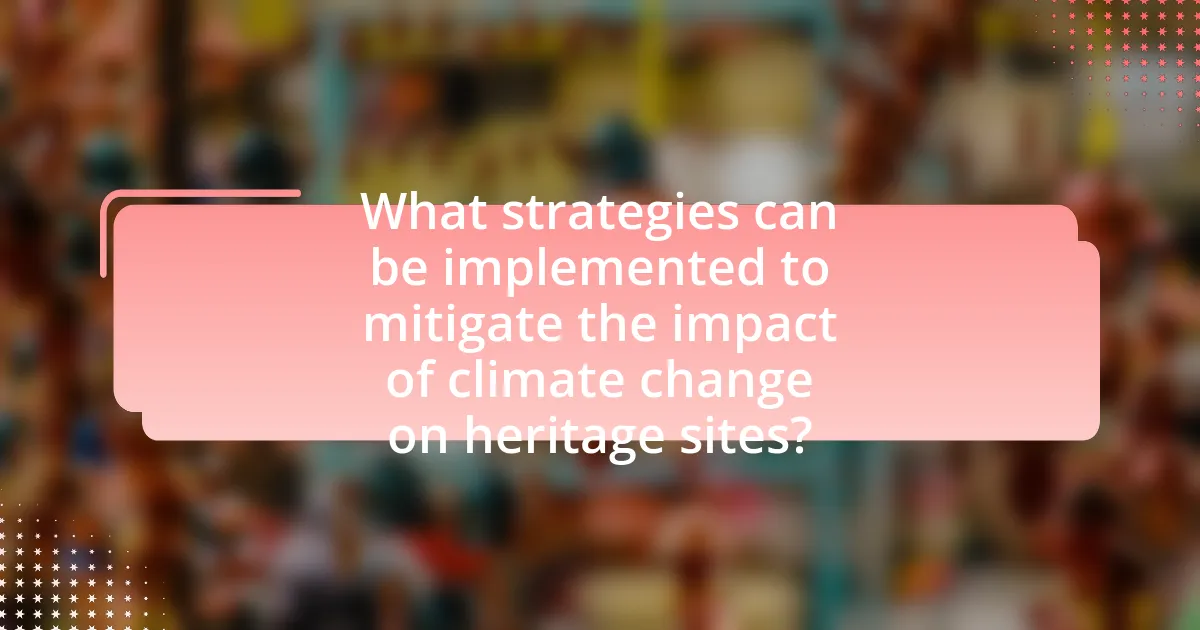Climate change, characterized by long-term shifts in temperature and weather patterns primarily due to human activities, poses significant threats to heritage sites worldwide. Over 30% of UNESCO World Heritage sites are at risk, with rising sea levels, increased flooding, and extreme weather events leading to structural damage and material degradation. The article explores how specific climate factors, such as rising temperatures and increased precipitation, contribute to the deterioration of these sites, emphasizing the urgent need for adaptive management strategies. It also highlights the cultural significance of heritage sites, their economic impact on local communities, and the role of technology and community engagement in conservation efforts.

What is Climate Change and Its Impact on Heritage Sites?
Climate change refers to long-term alterations in temperature, precipitation, wind patterns, and other elements of the Earth’s climate system, primarily driven by human activities such as fossil fuel combustion and deforestation. Its impact on heritage sites is significant, as rising temperatures, increased flooding, and extreme weather events threaten the structural integrity and preservation of these sites. For instance, the UNESCO World Heritage Centre has reported that over 30% of World Heritage sites are at risk due to climate change, with coastal sites like Venice facing severe flooding and erosion. This evidence underscores the urgent need for adaptive management strategies to protect cultural heritage from the adverse effects of climate change.
How does climate change affect the preservation of heritage sites?
Climate change negatively impacts the preservation of heritage sites by increasing the frequency and severity of extreme weather events, rising sea levels, and altering environmental conditions. For instance, UNESCO reports that rising temperatures and changing precipitation patterns can lead to erosion, flooding, and structural damage to historical buildings and monuments. Additionally, increased humidity and temperature can accelerate the deterioration of materials such as stone, wood, and metal, which are commonly used in heritage structures. The 2019 report by the Intergovernmental Panel on Climate Change highlights that many cultural sites are at risk of being lost or severely damaged due to climate-related factors, emphasizing the urgent need for adaptive preservation strategies.
What specific climate factors contribute to the deterioration of heritage sites?
Specific climate factors that contribute to the deterioration of heritage sites include rising temperatures, increased precipitation, and extreme weather events. Rising temperatures can lead to thermal expansion and contraction of materials, causing structural damage. Increased precipitation results in water infiltration, which can lead to erosion, mold growth, and material degradation. Extreme weather events, such as hurricanes and floods, can cause immediate and severe damage to heritage structures. According to the Intergovernmental Panel on Climate Change (IPCC), these factors are projected to intensify, posing significant risks to cultural heritage globally.
How do rising temperatures influence the structural integrity of these sites?
Rising temperatures negatively influence the structural integrity of heritage sites by accelerating material degradation and increasing the risk of thermal expansion. For instance, higher temperatures can lead to the deterioration of stone and masonry, as evidenced by studies showing that thermal stress can cause cracks and weaken structural bonds. Additionally, the International Council on Monuments and Sites reports that temperature fluctuations can exacerbate moisture-related issues, such as salt crystallization, which further compromises the stability of these sites.
Why is it important to protect heritage sites from climate change?
Protecting heritage sites from climate change is crucial because these sites hold significant cultural, historical, and educational value. Climate change poses threats such as rising sea levels, increased temperatures, and extreme weather events, which can lead to physical deterioration and loss of these irreplaceable assets. For instance, the United Nations Educational, Scientific and Cultural Organization (UNESCO) reports that over 50% of World Heritage Sites are already threatened by climate change impacts. This underscores the necessity of implementing protective measures to preserve the integrity and legacy of heritage sites for future generations.
What cultural significance do heritage sites hold for communities?
Heritage sites hold immense cultural significance for communities as they serve as tangible connections to history, identity, and shared values. These sites often embody the traditions, stories, and achievements of a community, fostering a sense of belonging and continuity. For instance, UNESCO recognizes over 1,100 World Heritage Sites, which not only highlight architectural and historical importance but also reflect the cultural diversity and heritage of the communities they represent. The preservation of these sites is crucial, as they contribute to local economies through tourism and education, while also promoting cultural pride and awareness among residents.
How does the loss of heritage sites impact local economies?
The loss of heritage sites negatively impacts local economies by reducing tourism revenue and diminishing cultural identity. Heritage sites often attract visitors, contributing significantly to local businesses such as hotels, restaurants, and shops. For instance, UNESCO estimates that cultural tourism accounts for approximately 40% of global tourism, highlighting the economic importance of these sites. When heritage sites are lost, communities experience job losses and decreased economic activity, leading to long-term financial instability. Additionally, the erosion of cultural identity can deter future investments, further harming local economies.

What are the specific impacts of climate change on different types of heritage sites?
Climate change significantly impacts various types of heritage sites through rising sea levels, increased temperatures, and extreme weather events. Coastal heritage sites, such as ancient ruins and historic ports, face erosion and flooding due to rising sea levels, with studies indicating that up to 70% of the world’s coastal archaeological sites are at risk. Built heritage, including historic buildings and monuments, suffers from temperature fluctuations that can cause material degradation; for instance, stone structures are vulnerable to freeze-thaw cycles that lead to cracking. Cultural landscapes, which encompass agricultural and natural heritage, are affected by changing climate patterns that disrupt traditional farming practices and biodiversity, threatening the integrity of these sites. Additionally, intangible heritage, such as traditional knowledge and practices, is at risk as communities adapt to climate change, potentially leading to the loss of cultural identity.
How does climate change affect archaeological sites?
Climate change adversely affects archaeological sites by accelerating erosion, altering soil composition, and increasing the frequency of extreme weather events. For instance, rising sea levels threaten coastal archaeological sites, while increased rainfall can lead to flooding, damaging structures and artifacts. A study published in the journal “Nature” highlights that approximately 40% of archaeological sites in the Mediterranean region are at risk due to climate-related impacts, underscoring the urgency of addressing these threats.
What are the risks posed by extreme weather events to archaeological sites?
Extreme weather events pose significant risks to archaeological sites, primarily through erosion, flooding, and temperature fluctuations. Erosion can lead to the loss of soil and sediment that supports these sites, while flooding can inundate and damage artifacts and structures. For instance, heavy rainfall can wash away fragile remains, as seen in the case of the ancient city of Pompeii, where increased rainfall has accelerated erosion. Additionally, temperature fluctuations can cause materials like wood and stone to expand and contract, leading to structural damage. The National Park Service reports that climate change-related extreme weather events have already impacted numerous archaeological sites across the United States, highlighting the urgent need for preservation efforts.
How does soil erosion impact the preservation of these sites?
Soil erosion significantly undermines the preservation of heritage sites by removing the topsoil that contains essential nutrients and archaeological artifacts. This loss of soil can lead to structural instability, exposing foundations and artifacts to further degradation from environmental factors. For instance, studies have shown that erosion can accelerate the deterioration of ancient structures, as seen in the case of the archaeological site of Pompeii, where erosion has contributed to the loss of historical context and integrity. Additionally, soil erosion can alter the landscape, making it difficult to maintain the original site conditions necessary for preservation efforts.
What challenges do climate change pose to architectural heritage?
Climate change poses significant challenges to architectural heritage, primarily through increased weather extremes, rising sea levels, and changing environmental conditions. These factors lead to deterioration of materials, structural instability, and loss of cultural significance. For instance, historic buildings made of stone or wood are particularly vulnerable to moisture and temperature fluctuations, which can cause erosion, cracking, and decay. Additionally, rising sea levels threaten coastal heritage sites, with UNESCO reporting that many such sites are at risk of submersion. The combination of these challenges necessitates urgent conservation efforts to protect architectural heritage from irreversible damage.
How do increased rainfall and flooding affect historic buildings?
Increased rainfall and flooding significantly damage historic buildings by causing structural deterioration and compromising their integrity. Water intrusion can lead to erosion of materials, such as stone and brick, and promote mold growth, which further weakens the structure. For instance, the National Park Service reports that prolonged exposure to moisture can accelerate the decay of historic wood and masonry, leading to costly repairs and potential loss of heritage. Additionally, flooding can disrupt the foundation of these buildings, causing shifts that may result in cracks and instability.
What role does humidity play in the degradation of materials used in heritage architecture?
Humidity significantly contributes to the degradation of materials used in heritage architecture by promoting biological growth, chemical reactions, and physical deterioration. High humidity levels can lead to the proliferation of mold, fungi, and bacteria, which can damage organic materials such as wood and textiles. Additionally, moisture can facilitate chemical reactions that cause corrosion in metals and deterioration in stone and masonry, as seen in the weathering of limestone and sandstone structures. For instance, the National Park Service reports that increased humidity accelerates the decay of historic buildings, particularly those constructed with porous materials that absorb moisture. This degradation not only affects the structural integrity of heritage sites but also compromises their aesthetic and historical value.

What strategies can be implemented to mitigate the impact of climate change on heritage sites?
To mitigate the impact of climate change on heritage sites, strategies such as implementing adaptive management practices, enhancing structural resilience, and conducting regular risk assessments can be employed. Adaptive management involves adjusting conservation strategies based on ongoing monitoring of climate impacts, ensuring that heritage sites remain protected as conditions change. Enhancing structural resilience includes reinforcing buildings and landscapes to withstand extreme weather events, which is crucial given that the Global Climate Change Report indicates that many heritage sites are increasingly vulnerable to flooding and erosion. Regular risk assessments help identify specific threats posed by climate change, allowing for targeted interventions that preserve the integrity of these sites.
How can heritage site managers adapt to climate change?
Heritage site managers can adapt to climate change by implementing risk assessment and management strategies tailored to specific vulnerabilities of their sites. These strategies include conducting thorough climate impact assessments to identify potential threats such as rising sea levels, increased rainfall, or temperature fluctuations. For instance, the UNESCO World Heritage Centre emphasizes the importance of integrating climate adaptation into site management plans, which can involve enhancing drainage systems to prevent flooding or using materials that are more resilient to temperature changes. Additionally, managers can engage in community education and collaboration to foster local stewardship, ensuring that the cultural significance of the site is preserved while adapting to environmental changes.
What best practices can be adopted for the conservation of vulnerable sites?
Best practices for the conservation of vulnerable sites include implementing adaptive management strategies, conducting regular assessments, and engaging local communities. Adaptive management allows for flexible responses to changing environmental conditions, ensuring that conservation efforts remain effective over time. Regular assessments, such as environmental impact studies, help identify potential threats and inform necessary adjustments to conservation plans. Engaging local communities fosters stewardship and ensures that conservation practices align with cultural values and local knowledge, enhancing the sustainability of efforts. These practices are supported by case studies demonstrating their effectiveness in preserving heritage sites in the face of climate change.
How can technology assist in monitoring and preserving heritage sites?
Technology assists in monitoring and preserving heritage sites through the use of advanced tools such as remote sensing, drones, and Geographic Information Systems (GIS). Remote sensing enables the detection of changes in the environment surrounding heritage sites, allowing for timely interventions. Drones provide high-resolution aerial imagery that can identify structural damage or erosion, facilitating targeted preservation efforts. GIS integrates spatial data to analyze the impact of climate change on these sites, helping to prioritize conservation strategies. For instance, a study by the University of Cambridge highlighted how GIS mapping has been used to assess vulnerability in heritage sites across Europe, demonstrating the effectiveness of technology in safeguarding cultural heritage against climate-related threats.
What role do communities play in protecting heritage sites from climate change?
Communities play a crucial role in protecting heritage sites from climate change by actively engaging in conservation efforts and advocating for sustainable practices. Local populations often possess traditional knowledge and cultural connections to these sites, which can inform effective preservation strategies. For instance, community-led initiatives, such as the restoration of local ecosystems or the implementation of adaptive management practices, have been shown to enhance the resilience of heritage sites against climate-related threats. Research indicates that when communities are involved in decision-making processes, the outcomes are more sustainable and culturally relevant, as seen in projects like the UNESCO World Heritage Sites where local stewardship has led to improved site management and protection against climate impacts.
How can local engagement enhance conservation efforts?
Local engagement enhances conservation efforts by fostering community ownership and participation in protecting heritage sites. When local communities are actively involved, they are more likely to prioritize conservation, leading to sustainable practices that align with their cultural values. For instance, studies show that community-led initiatives can increase the effectiveness of conservation strategies by up to 50%, as local knowledge and resources are utilized. Additionally, engaging locals can lead to increased funding and volunteer support, as seen in projects like the “Community Conservation Program” in Madagascar, which successfully mobilized local populations to protect biodiversity while preserving cultural heritage.
What educational initiatives can raise awareness about the importance of heritage site preservation?
Educational initiatives that can raise awareness about the importance of heritage site preservation include community workshops, school programs, and online campaigns. Community workshops engage local populations by providing hands-on experiences related to heritage conservation, fostering a sense of ownership and responsibility. School programs can integrate heritage education into curricula, teaching students about the historical and cultural significance of local sites, which can lead to increased advocacy for preservation. Online campaigns utilize social media platforms to disseminate information and mobilize support, reaching a broader audience and encouraging public participation in preservation efforts. These initiatives are effective as they directly involve individuals in the preservation process, making the importance of heritage sites more tangible and relevant to their lives.
What practical steps can individuals take to support heritage site conservation?
Individuals can support heritage site conservation by actively participating in local conservation efforts and promoting awareness about the importance of these sites. Engaging in volunteer programs organized by heritage organizations allows individuals to contribute directly to preservation activities, such as restoration projects or clean-up events. Additionally, individuals can advocate for policies that protect heritage sites from climate change impacts, such as supporting legislation aimed at reducing carbon emissions. Financial contributions to reputable heritage conservation organizations can also provide essential funding for preservation initiatives. According to UNESCO, community involvement is crucial for the sustainability of heritage sites, as it fosters a sense of ownership and responsibility among local populations.


